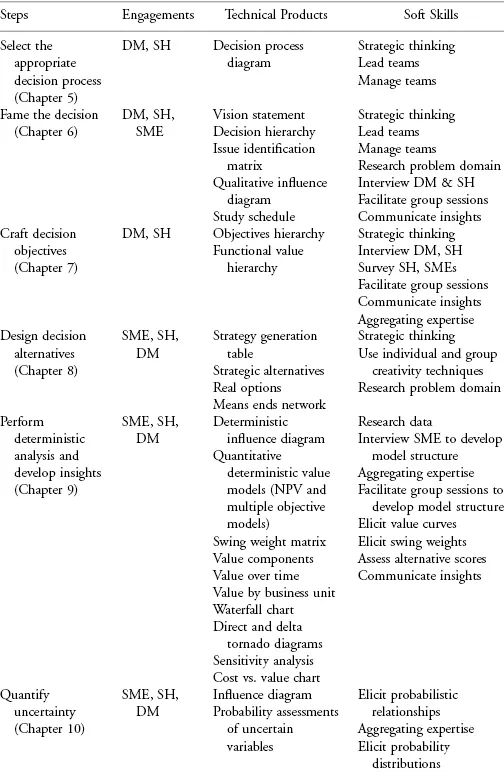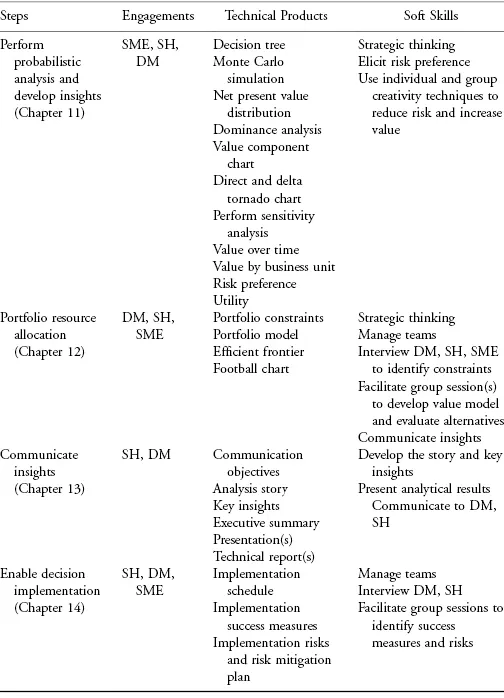![]()
CHAPTER ONE
Introduction to Decision Analysis
GREGORY S. PARNELL and TERRY A. BRESNICK
Nothing is more difficult, and therefore more precious, than to be able to decide.
—Napoleon, “Maxims,” 1804
1.1 Introduction
1.2 Decision Analysis Is a Socio-Technical Process
1.3 Decision Analysis Applications
1.3.1 Oil and Gas Decision Analysis Success Story: Chevron
1.3.2 Pharmaceutical Decision Analysis Success Story: SmithKline Beecham
1.3.3 Military Decision Analysis Success Stories
1.4 Decision Analysis Practitioners and Professionals
1.4.1 Education and Training
1.4.2 Decision Analysis Professional Organizations
1.4.3 Problem Domain Professional Societies
1.4.4 Professional Service
1.5 Handbook Overview and Illustrative Examples
1.5.1 Roughneck North American Strategy (RNAS) (by Eric R. Johnson)
1.5.2 Geneptin Personalized Medicine for Breast Cancer (by Sean Xinghua Hu)
1.5.3 Data Center Location and IT Portfolio (by Gregory S. Parnell and Terry A. Bresnick)
1.6 Summary
Key Terms
References
1.1 Introduction
The consequences of our decisions directly affect our professional and personal lives. As Napoleon noted in our opening quote, decisions can be difficult, and making good decisions can be very valuable. Our focus is on professional decisions, but the same principles apply to our personal decisions.
We begin by defining a decision. Professor Ronald Howard of Stanford University defines a decision as an irrevocable allocation of resources (Howard, 1988). Consider the contracting process used by many companies and organizations. The company does not make a decision to buy a product or service when they begin thinking about the procurement. They make the decision when they sign a legally binding contract, which obligates them to provide resources (typically dollars) to the supplier of the product or service. Can they change their mind? Absolutely, but they may have to pay contract cancellation fees.
A decision is an irrevocable allocation of resources.
Decisions are made by people vested with the authority and responsibility to make decisions for an organization or enterprise. Many decisions involve stakeholders who are individuals and organizations that could be affected by the future consequences of the decision. Some decisions are easy because few stakeholders are involved, the values are clear, good alternatives are readily identified, and there are few uncertainties. However, some difficult decisions involve many stakeholders with potentially conflicting objectives, complex alternatives, significant uncertainties, and large consequences. The discipline of decision analysis, the focus of this handbook, has been developed to help decision makers with these complex decisions.
There are many definitions of decision analysis. Howard, who coined the term “decision analysis” (Howard, 1966), defines decision analysis as “a body of knowledge and professional practice for the logical illumination of decision problems.” In the first book on decision analysis, Howard Raiffa of Harvard University defined decision analysis as an approach that “prescribes how an individual faced with a problem of choice under uncertainty should go about choosing a course of action that is consistent with personal basic judgments and preferences” (Raiffa, 1968). Ralph Keeney of Duke University (Keeney, 1982) provides an intuitive and a technical definition. Keeney’s intuitive definition is “a formalization of common sense for decision problems that are too complex for informal use of common sense.” His technical definition is “a philosophy, articulated by a set of logical axioms, and a methodology and collection of systematic procedures, based on those axioms, for responsibly analyzing the complexities inherent in decision problems.” Professor Larry Phillips of the London School of Economics emphasizes that decision analysis is a socio-technical process to provide insights to decision makers in organizations (Phillips et al., 1990) and (Phillips, 2005). In a popular decision analysis textbook, Clemen and Reilly state that “decision analysis provides effective methods for organizing a problem into a structure that can be analyzed. In particular, elements of a decision’s structure include the possible courses of action, the possible outcomes that could result, the likelihood of those outcomes, and eventual consequences (e.g., costs and benefits) to be derived from the different outcomes” (Clemen & Reilly, 2001). We will use the following definition of decision analysis:
Decision analysis is a philosophy and a social-technical process to create value for decision makers and stakeholders facing difficult decisions involving multiple stakeholders, multiple (possibly conflicting) objectives, complex alternatives, important uncertainties, and significant consequences. Decision analysis is founded on an axiomatic decision theory and uses insights from the study of decision making.
In decision analysis, we distinguish between a good decision and a good outcome. A good decision is one that is logically consistent with our preferences for the potential outcomes, our alternatives, and our assessment of the uncertainties. A good outcome is the occurrence of a favorable event—one that we like. We believe that consistently making good decisions will lead to more good outcomes than otherwise. However, since there is uncertainty, even a good decision process may not always lead to a good outcome. Of course, a bad decision does not always result in a bad outcome—sometimes we can be lucky and obtain a good outcome. Unfortunately, we cannot count on being lucky.
The purpose of our handbook is to describe the best practices that decision analysts have found the most useful in helping decision makers make good decisions when faced with difficult and important choices. Since many individuals and social organizations are involved in complex decisions, to be successful, decision analysis must use a socio-technical process to help those individuals and organizations make decisions. Socially, the purpose of decision analysis is to provide credible, understandable, and timely insights to decision makers and key stakeholders in organizations. Technically, decision analysis is an operations research/management science discipline that uses probability, value, and utility theory (see Chapter 3) to analyze complex alternatives, under significant uncertainty, to provide value for stakeholders with multiple (and possibly conflicting) objectives. Since it relies on the reasonable axioms of choice (Chapter 3), decision analysis identifies decisions that are logically consistent with our preferences, our alternatives, and our assessment of the uncertainties.
This chapter introduces the field of decision analysis and defines some of the key terms that we use in the handbook. The chapter is organized as follows. Section 1.2 further describes decision analysis as a socio-technical process. We introduce the decision analysis process that we use in the handbook and use the process to list the key technical concepts and techniques and the soft skills necessary to help organizations create potential value for themselves and their stakeholders. Section 1.3 emphasizes that decision analysis has many significant applications and compares three important application areas: oil and gas, pharmaceuticals, and defense. We also briefly describe four decision analysis success stories. Section 1.4 defines the decision professional, discusses the education and training of decision professionals, identifies some of their major professional societies, and describes some of their professional service activities. Section 1.5 provides an overview of the handbook and introduces the three substantive illustrative examples used in the handbook. Section 1.6 provides a summary of the key ideas in the chapter.
1.2 Decision Analysis Is a Socio-Technical Process
An effective decision analyst must understand the challenges of decision making in organizations, the mathematical foundations of decision analysis, and the soft skills required to work with decision makers, stakeholders, and experts to perform a decision analysis. In this section, we describe the decision analysis process used in the handbook and use that process (and our experience) to identify the critical soft skills that are essential for the successful use of decision analysis.
There are several decision processes (see Chapter 6) that have been used by decision analysts to integrate the contributions of decision makers (DMs), stakeholders1 (SH), subject matter experts (SMEs), and decision analysts to reach a good decision. Figure 1.1 shows the decision analysis process that we use to organize the handbook. The decision frame is how we view the decision opportunity. At the center of the figure is a reminder that our purpose is to use best practices to create value for DMs and SH. The steps in the process are shown as 10 boxes around the center. Although sequential arrows are used in the figure, the process is iterative. The order of the steps should be tailored to the application and some steps may not apply. For example, if the decision is a choice of the best alternative, the portfolio resource allocation chapter would not apply. Also, some steps can be combined. For example, the decision framing and crafting of the decision objectives may be done at the same time. In addition, some steps may not be required in a particular application. Twelve environmental factors are placed in the decision frame of Figure 1.1, but outside the decision analysis process cycle to highlight the important considerations that apply in many of the steps of the decision analysis process. The location of a factor is not necessarily an indication of alignment with a particular step in the process. The 12 factors are meant to be illustrative and not all inclusive.
Next, we use this decision analysis process to identify the decision analysis technical products and soft skills that are essential for the decision professional. We identify these skills in Table 1.1 with steps in the process. Soft skills include personal and interpersonal skills.
TABLE 1.1 List of Technical Products and Soft Skills
Based on our experience and the above analysis, we aggregate the soft skills into the following nine categories.
- Thinking strategically about the client organization, the problem domain, and the role of the decision analysis in achieving the current strategy or, when appropriate, developing a new strategy, and new decision opportunities
- Leading teams...



